英语倒装句详解
倒装句的用法总结

倒装句的用法总结倒装句在英语语法中属于一种特殊句型,它能够使语言表达更加灵活多样。
倒装句的用法有时会让人感到困惑,因此本文将对倒装句的基本形式、用途及注意事项进行总结和解释。
一、什么是倒装句?倒装句是指将英语中主语和谓语动词的位置颠倒的现象。
通常来说,在陈述句中主语位于谓语动词之前;但在某些情况下,为了强调某个信息或改变语气,可以将主语和谓语动词颠倒顺序。
二、基本形式1. 完全倒装:即将助动词、情态动词或连系动词放在主语之前。
Examples:- Had she arrived?(她到了吗?)- Can you swim?(你会游泳吗?)- Is it a cat?(那是一只猫吗?)2. 部分倒装:即将助动词、情态动词或连系动词与其后面的其他成分颠倒顺序。
Examples:- Not only did he finish his homework, but also he helped his classmates.(他不仅完成了作业,还帮助了同学们)- At no time does he admitted his mistakes.(他从未承认过他的错误)三、倒装句的用途1. 当以否定词开头表达“部分否定”的意思时,常常使用完全倒装。
Example:- Never have I seen such a beautiful sunset.(我从未见过如此美丽的日落)2. 在虚拟条件句中,通常采用部分倒装。
Example:- Should you need any assistance, please let me know.(如果你需要任何帮助,请告诉我)3. 在介词短语置于句首时,为了避免重复或强调信息,可以使用完全或部分倒装。
Examples:- Off the table fell a plate.(桌子上掉下了一只盘子)- Into the room walked a toddler and her mother.(一个蹒跚学步的小孩和她的妈妈走进了房间)四、注意事项1. 只有助动词、情态动词和连系动词才能发生倒装。
英语语法 什么是倒装句

英语语法什么是倒装句倒装句是一种特殊的语法结构,在英语语法中有着重要的地位。
正常语序中,主语通常出现在动词之前,而倒装句则将动词或助动词置于主语之前,或者将整个谓语或短语置于主语之前。
这种颠倒的语序在英语中具有特殊的语法和修辞效果,常用于强调、疑问、条件句等语境中。
以下是倒装句的几种常见形式和用法:1. 完全倒装:将助动词或系动词放在主语之前。
例如:- Never have I seen such a beautiful sunset.- Only in dreams can we truly fly.2. 部分倒装:将助动词、情态动词或动词的某些部分放在主语之前。
例如:- Hardly had he arrived when the phone rang.- Not only did she finish the report, but she also submitted it early.3. 带有否定词的倒装:将否定词放在句首,然后倒装动词和主语的顺序。
例如:- Never have I felt so alone.- Not until the rain stopped did they go outside.4. 疑问倒装:将助动词或情态动词提到句首,以形成疑问句。
例如:- Is he coming to the party?- Can you speak French?5. 条件句中的倒装:当条件句以介词短语或副词短语开头时,常常使用倒装结构。
例如:- In case of fire, break the glass.- Should you need any assistance, please let us know.倒装句的使用可以使句子更具有强调和修辞效果,增加句子的变化和多样性。
但需要注意的是,倒装句的使用需要根据具体的语境和句子结构来判断,不是所有情况下都适用。
因此,在使用倒装句时,需要注意语法规则和语义逻辑的准确性。
太全了!英语倒装句的用法详解

太全了!英语倒装句的用法详解倒装是一种语法手段,用于表示一定的句子结构或强调某一句子成分。
倒装句有两种:完全倒装和部分倒装。
完全倒装1) 完全倒装即把整个谓语放到主语之前(是整个谓语动词,而非助动词)。
例如:The teacher came in and the class began.(没有倒装)In came the teacher and the class began. (老师走了进来,然后开始上课。
)2) there引出的完全倒装句:除了最常见的there be句型以外,there还可以接appear, exist, lie, remain, seem to be, stand等,一般都译成'有'的含义,构成完全倒装句。
例如:There appeared to be a man in black in the distance.(远处有个穿黑色衣服的人。
)3) 由地点和时间副词引出的完全倒装句:以地点副词here, there 和时间副词now, then 开头,后面的动词是be, come, exist, fall, follow, go, lie, remain, seem, stand等,而主语又是名词时,构成完全倒装句。
Up climbed the boy when his mother came.4)表示运动方向的副词或地点状语置于句首,谓语表示运动的动词且主语是名词时使用完全倒装5)在强调状语时(1)当句首状语为方位词或拟声词,谓语动词为go, come等表示位置转移的动词时句子须倒装。
例如:1 Up went the plane.2 In came the chairman and the meeting began.注:如果主语是代词则不发生倒装。
例如:1 Out they rushed!2 Lower and lower he bent.(2) 当句首状语为表示地点的介词词组时,句子须倒装。
英语倒装句12种类型及例句
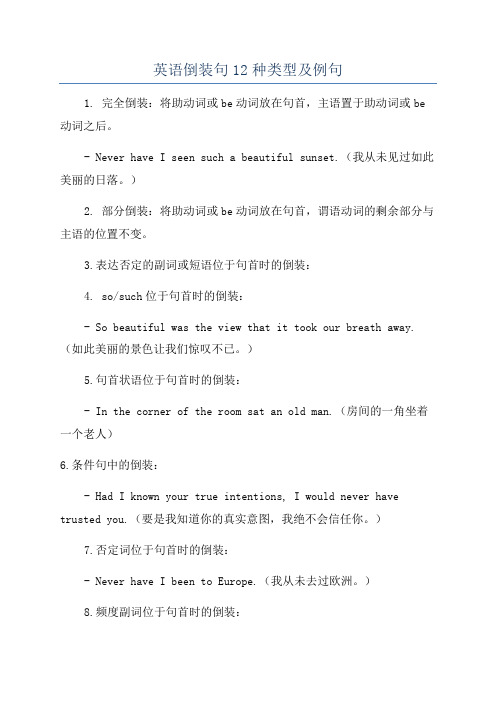
英语倒装句12种类型及例句1. 完全倒装:将助动词或be动词放在句首,主语置于助动词或be 动词之后。
- Never have I seen such a beautiful sunset.(我从未见过如此美丽的日落。
)2. 部分倒装:将助动词或be动词放在句首,谓语动词的剩余部分与主语的位置不变。
3.表达否定的副词或短语位于句首时的倒装:4. so/such位于句首时的倒装:- So beautiful was the view that it took our breath away.(如此美丽的景色让我们惊叹不已。
)5.句首状语位于句首时的倒装:- In the corner of the room sat an old man.(房间的一角坐着一个老人)6.条件句中的倒装:- Had I known your true intentions, I would never have trusted you.(要是我知道你的真实意图,我绝不会信任你。
)7.否定词位于句首时的倒装:- Never have I been to Europe.(我从未去过欧洲。
)8.频度副词位于句首时的倒装:- Rarely do we see such dedication.(我们很少见到如此的奉献精神。
)9.祈使句或祈使句部分的倒装:- Stand up!(站起来!)- Be quiet, please.(请安静。
)10. only位于句首时的倒装:- Only by working hard can you achieve your goals.(只有通过努力工作,你才能实现目标。
)11.地点状语置于句首时的倒装:- In the garden were beautiful flowers.(花园里有美丽的花朵。
)12.宾语置于句首时的倒装:- A love like this I have never felt before.(我之前从未感受过如此的爱。
英语 倒装句讲解.
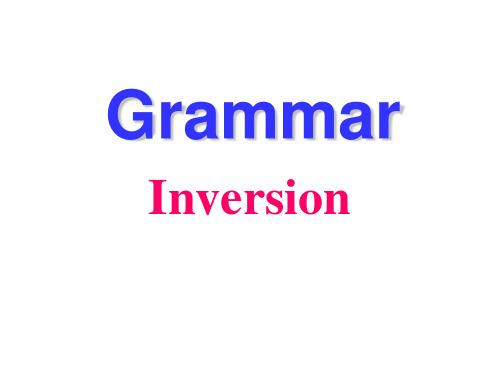
Here comes the bus.
Out rushed the puppy.
Away went the girl.
注意: 代词作主语时, 主谓语序不变。 Here it is. In he comes.
3. 当句首状语是表示地点的介词词组时, 也常引起全部倒装。
South of the city lies a big steel factory. From the valley came a frightening sound. Under the tree stands a little boy.
由 If you had reviewed your lessons 这样一个虚拟条件分句变过来的。
3. 用于“形容词(或名词、动词)+ as (though)” 引导的让步状语从句。 Pretty as she is, she is not clever. Try as he would, he might fail again. Money as they had, they don’t know how to spend it.
全部倒装
1. 用于 there be 句型。 There are many students in the classroom. 主语位于谓语 are there之后 原句自然顺序是:
Many students are there in the classroom.
2. 用于“here (there, now, then) + 不及 物动词 + 主语的句型中, 或以out, in, up, down, away 等副词开头的句子里 面,表示强调。
部分倒装:NAOSHI
1.I was so interested in this video game that I didn’t notice my father was behind me. So interested was I…
高中英语知识点归纳倒装句的用法

高中英语知识点归纳倒装句的用法倒装句是英语中的一种常见语法现象,它与一般的语序有所不同。
在倒装句中,谓语动词不再位于句子的中间,而是移到主语之前或状语之前,这种语法结构的运用可以使句子显得更加生动有趣。
下面将对高中英语中常见的倒装句进行归纳总结。
一、完全倒装句完全倒装句是指将助动词、情态动词或系动词放在主语之前,句子的谓语动词则位于主语之后。
完全倒装句的结构为:助动词/情态动词/系动词+主语+谓语动词+其他。
1.助动词完全倒装句助动词包括be动词、have动词和do动词。
当句子以副词here、there或表示方向的副词(如up、down、in、out等)开头时,为了突出地点或方向,可以采用助动词完全倒装的形式。
例如:Here comes the bus.There is a cat under the table.Down came the rain.2.情态动词完全倒装句情态动词包括can、could、may、might、must、shall、should、will、would等。
在表示祝愿、建议、命令等意义时,可以采用完全倒装的形式。
例如:May you have a happy birthday!Should you need any help, feel free to ask.Will you please close the door?3.系动词完全倒装句系动词包括be动词、seem、appear、look、sound等。
在表示位置、方式、状态、主语特征等方面时,可以采用系动词完全倒装的形式。
例如:On the table lies a book.How beautiful the flowers are!Tired as he was, he kept working.二、部分倒装句部分倒装句是指将谓语动词的一部分(通常是助动词或情态动词)与主语之间的位置对调,这种语法结构常见于否定句、选择疑问句和以感叹词开头的句子。
英语倒装句的用法讲解
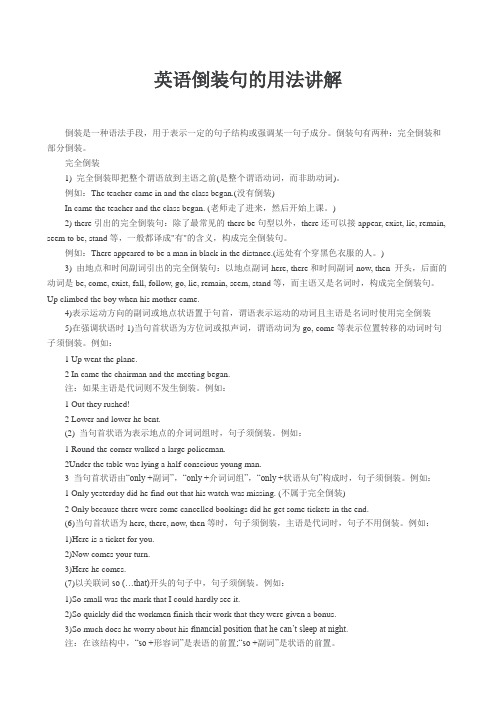
英语倒装句的用法讲解倒装是一种语法手段,用于表示一定的句子结构或强调某一句子成分。
倒装句有两种:完全倒装和部分倒装。
完全倒装1) 完全倒装即把整个谓语放到主语之前(是整个谓语动词,而非助动词)。
例如:The teacher came in and the class began.(没有倒装)In came the teacher and the class began. (老师走了进来,然后开始上课。
)2) there引出的完全倒装句:除了最常见的there be句型以外,there还可以接appear, exist, lie, remain, seem to be, stand等,一般都译成"有"的含义,构成完全倒装句。
例如:There appeared to be a man in black in the distance.(远处有个穿黑色衣服的人。
)3) 由地点和时间副词引出的完全倒装句:以地点副词here, there和时间副词now, then 开头,后面的动词是be, come, exist, fall, follow, go, lie, remain, seem, stand等,而主语又是名词时,构成完全倒装句。
Up climbed the boy when his mother came.4)表示运动方向的副词或地点状语置于句首,谓语表示运动的动词且主语是名词时使用完全倒装5)在强调状语时1)当句首状语为方位词或拟声词,谓语动词为go, come等表示位置转移的动词时句子须倒装。
例如:1 Up went the plane.2 In came the chairman and the meeting began.注:如果主语是代词则不发生倒装。
例如:1 Out they rushed!2 Lower and lower he bent.(2) 当句首状语为表示地点的介词词组时,句子须倒装。
英语中的倒装句详解
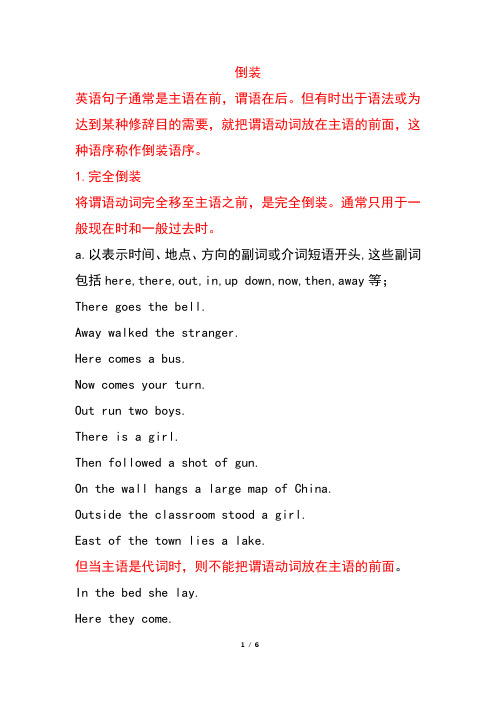
倒装英语句子通常是主语在前,谓语在后。
但有时出于语法或为达到某种修辞目的需要,就把谓语动词放在主语的前面,这种语序称作倒装语序。
1.完全倒装将谓语动词完全移至主语之前,是完全倒装。
通常只用于一般现在时和一般过去时。
a.以表示时间、地点、方向的副词或介词短语开头,这些副词包括here,there,out,in,up down,now,then,away等;There goes the bell.Away walked the stranger.Here comes a bus.Now comes your turn.Out run two boys.There is a girl.Then followed a shot of gun.On the wall hangs a large map of China.Outside the classroom stood a girl.East of the town lies a lake.但当主语是代词时,则不能把谓语动词放在主语的前面。
In the bed she lay.Here they come.Away they went.There he is.Back he fight.b.进行时和被动语态的倒装A boy is sitting at the table.(正常语序)Sitting at the table is a boy.(倒装语序)At the table is sitting a boy. (倒装语序)An old man was killed on the road. (正常语序)Killed on the road was an old man. (倒装语序)On the road was killed an old man. (倒装语序)2.部分倒装部分倒装是指将谓语动词的一部分(Be动词、助动词、情态动词,如无,加do、did、does)放在主语的前面。
英语倒装句详解
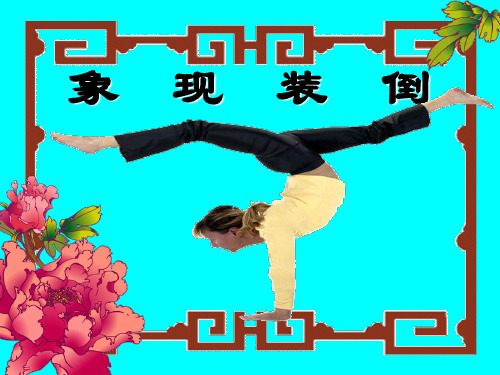
9. ------Where is your father?
A -------Oh,_______.
A here he comes B he here comes C here does he come D here comes he
(例9)
So loudly did he speak that even people in the next room could hear him. In such a hurry did he leave that he forgot to lock the door.
So moved was she that she could not say a word. 她激动得一句话也说不出来。 在“so+副词…that分句”结构中,如将 “so+副词”置于句首以示强调时,其后的 主谓作部分倒装。如: So loudly did he speak that even the people in the next room could hear him.他的声音那么大,连隔壁屋子里的人 都听得见。
单数可数名词作表语提前不用冠词
Young as he is, he knows more than you.
强化练习 1 _____the plane. C A Down flying B Down was flying
C Down flew
D Flew down
D 2 Under a big tree ____,half asleep.
二,部分倒装
英语倒装句的用法归纳总结
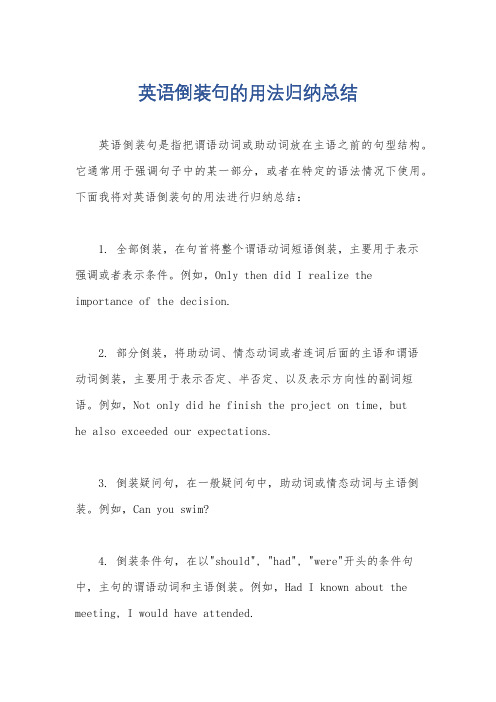
英语倒装句的用法归纳总结
英语倒装句是指把谓语动词或助动词放在主语之前的句型结构。
它通常用于强调句子中的某一部分,或者在特定的语法情况下使用。
下面我将对英语倒装句的用法进行归纳总结:
1. 全部倒装,在句首将整个谓语动词短语倒装,主要用于表示
强调或者表示条件。
例如,Only then did I realize the importance of the decision.
2. 部分倒装,将助动词、情态动词或者连词后面的主语和谓语
动词倒装,主要用于表示否定、半否定、以及表示方向性的副词短语。
例如,Not only did he finish the project on time, but
he also exceeded our expectations.
3. 倒装疑问句,在一般疑问句中,助动词或情态动词与主语倒装。
例如,Can you swim?
4. 倒装条件句,在以"should", "had", "were"开头的条件句中,主句的谓语动词和主语倒装。
例如,Had I known about the meeting, I would have attended.
5. 倒装句型用于表示方向性的副词短语,如,Here comes the bus.
总的来说,英语倒装句的使用有一定的规律,主要用于强调、
条件句、疑问句和特定的副词短语。
在写作和口语表达中,合适地
运用倒装句可以使语言更加生动有力。
希望以上总结对你有所帮助。
英语倒装句的详细讲解
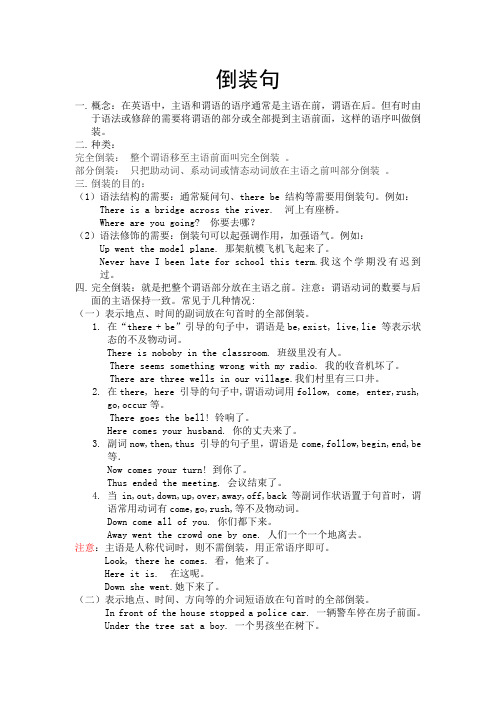
倒装句一. 概念:在英语中,主语和谓语的语序通常是主语在前,谓语在后。
但有时由于语法或修辞的需要将谓语的部分或全部提到主语前面,这样的语序叫做倒装。
二. 种类:完全倒装:整个谓语移至主语前面叫完全倒装。
部分倒装:只把助动词、系动词或情态动词放在主语之前叫部分倒装。
三. 倒装的目的:(1)语法结构的需要:通常疑问句、there be 结构等需要用倒装句。
例如:There is a bridge across the river. 河上有座桥。
Where are you going? 你要去哪?(2)语法修饰的需要:倒装句可以起强调作用,加强语气。
例如:Up went the model plane. 那架航模飞机飞起来了。
Never have I been late for school this term. 我这个学期没有迟到过。
四. 完全倒装:就是把整个谓语部分放在主语之前。
注意:谓语动词的数要与后面的主语保持一致。
常见于几种情况:(一)表示地点、时间的副词放在句首时的全部倒装。
1.在“there + be”引导的句子中,谓语是be,exist, live,lie 等表示状态的不及物动词。
There is noboby in the classroom. 班级里没有人。
There seems something wrong with my radio. 我的收音机坏了。
There are three wells in our village.我们村里有三口井。
2.在there, here 引导的句子中,谓语动词用follow, come, enter,rush,go,occur等。
There goes the bell! 铃响了。
Here comes your husband. 你的丈夫来了。
3.副词now,then,thus 引导的句子里,谓语是come,follow,begin,end,be等.Now comes your turn! 到你了。
英语倒装句详解
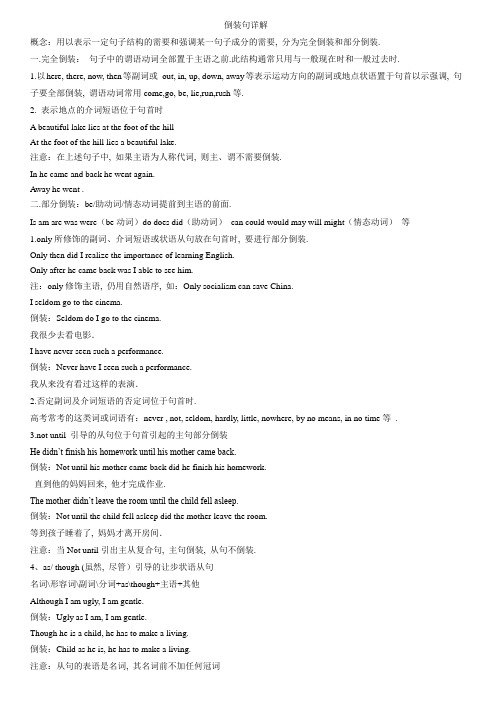
倒装句详解概念:用以表示一定句子结构的需要和强调某一句子成分的需要, 分为完全倒装和部分倒装.一.完全倒装:句子中的谓语动词全部置于主语之前.此结构通常只用与一般现在时和一般过去时.1.以here, there, now, then等副词或out, in, up, down, away等表示运动方向的副词或地点状语置于句首以示强调, 句子要全部倒装, 谓语动词常用come,go, be, lie,run,rush等.2. 表示地点的介词短语位于句首时A beautiful lake lies at the foot of the hillAt the foot of the hill lies a beautiful lake.注意:在上述句子中, 如果主语为人称代词, 则主、谓不需要倒装.In he came and back he went again.Away he went .二.部分倒装:be/助动词/情态动词提前到主语的前面.Is am are was were(be动词)do does did(助动词)can could would may will might(情态动词)等1.only所修饰的副词、介词短语或状语从句放在句首时, 要进行部分倒装.Only then did I realize the importance of learning English.Only after he came back was I able to see him.注:only修饰主语, 仍用自然语序, 如:Only socialism can save China.I seldom go to the cinema.倒装:Seldom do I go to the cinema.我很少去看电影.I have never seen such a performance.倒装:Never have I seen such a performance.我从来没有看过这样的表演.2.否定副词及介词短语的否定词位于句首时.高考常考的这类词或词语有:never , not, seldom, hardly, little, nowhere, by no means, in no time等.3.not until 引导的从句位于句首引起的主句部分倒装He didn’t finish his homework until his mother came back.倒装:Not until his mother came back did he finish his homework.直到他的妈妈回来, 他才完成作业.The mother didn’t leave the room until the child fell asleep.倒装:Not until the child fell asleep did the mother leave the room.等到孩子睡着了, 妈妈才离开房间.注意:当Not until引出主从复合句, 主句倒装, 从句不倒装.4、as/ though (虽然, 尽管)引导的让步状语从句名词\形容词\副词\分词+as\though+主语+其他Although I am ugly, I am gentle.倒装:Ugly as I am, I am gentle.Though he is a child, he has to make a living.倒装:Child as he is, he has to make a living.注意:从句的表语是名词, 其名词前不加任何冠词5.用于so nor neither 开头的句子A、So +be/助动词/情态动词+主语某人也是如此Nor/neither +be/助动词/情态动词+主语某人也不是如此1). 他喜欢读书, 我也是.He likes reading very much. So do I .2). 我从来没有去过广州大学, 他也是.I have never been to Guangzhou University, neither/ nor has he.Betty is a nice girl. So she isB、So +主语+be/助动词/情态动词某人确实如此6.在hardly/scarcely/…when;no sooner…than; not only … but also;so...that; such…that 的倒装句中, 前倒后不倒. hardly/scarcely/ no sooner后句子的谓语用had done, when/than后句子的谓语用一般过去时(1) Hardly / Scarcely had he fallen asleep when a loud knock at the door awaked him.(2) No sooner had I reached the station than train moved.(3) Not only is he interested in football but also he plays it well.(4) So hard does he work that he has made great progress in English.7. If 虚拟条件从句中.从句有(were/should/had)1)If I were you, I would work hard. 倒装:Were I you, I would work hard.2) If it should rain tomorrow, we would put off our meeting.倒装: Should it rain tomorrow, we would put off our meeting.3)If he had followed my advice, he would have succeeded.倒装:Had he followed my advice, he would have succeeded.8.May置句首, 表示祝愿.May you succeed.祝你成功!补充知识1.全部倒装全部倒装是只将句子中的谓语动词全部置于主语之前.此结构通常只用于一般现在时和一般过去时.常见的结构有:1)here, there, now, then, thus等副词置于句首, 谓语动词常用be, come, go, lie, run等表示来去或状态的动词.Then came the chairman. 那时总裁来了.Here is your letter. 你的信.2)表示运动方向的副词或地点状语置于句首, 谓语表示运动的动词.Out rushed a missile from under the bomber. 轰炸机肚底下窜出一枚导弹.Ahead sat an old woman. 前面坐着一个老妪.注意:上述全部倒装的句型结构的主语必须是名词, 如果主语是人称代词则不能完全倒装.Here he comes. 他来了.Away they went. 他们走开了.2.部分倒装部分倒装是指将谓语的一部分如助动词或情态倒装至主语之前.如果句子的谓语没有助动词或情态动词, 则需添加助动词do, does或did, 并将其置于主语之前.1.句首为否定或半否定的词语, 如no, not, never, seldom, little, hardly, at no time决不, in no way, not until… 等. Never have I seen such a performance. 从未见过如此糟糕的表演.Nowhere will you find the answer to this question. 无论如何你不会找到这个问题的答案的.Not until the child fell asleep did the mother leave the room. 母亲一直到孩子入睡后离开房间.2.当Not until引出主从复合句, 主句倒装, 从句不倒装.注意:如否定词不在句首不倒装.I have never seen such a performance. ---never have I seen such a performance.The mother didn\'t leave the room until the child fell asleep.---not until the child fell asleep the mother did leave the room.改写为正常语序为, Man did not know what heat is until the early years of the 19th. 现在将not提前, 后面就不能再用否定了,否则意思就变了.3.以否定词开头作部分倒装如Not only…but also, Hardly/Scarcely…when, No sooner… than等, 要倒装.Not only did he refuse the gift, he also severely criticized the sender. 他没有收下礼物, 还狠狠批评了送礼的人. Hardly had she gone out when a student came to visit her. 她刚出门, 就有个学生来访.No sooner had she gone out than a student came to visit her. 她刚出门, 就有个学生来访.4. so, neither, nor作部分倒装用这些词表示\"也\"、\"也不\" 的句子要部分倒装.Tom can speak French. So can Jack. 汤姆会讲法语, 杰克也会.If you won\'t go, neither will I.你不去, 我也不去.注意:当so引出的句子用以对上文内容加以证实或肯定时, 不可用倒装结构.意为\"的确如此\".Tom asked me to go to play football and so I did. 汤姆邀我去踢球, 我去了.---It\'s raining hard.---So it is. 雨下得真大.是呀.5. only在句首倒装的情况.Only in this way, can you learn English well. 只有这样, 你才能学好英语.Only after being asked three times did he come to the meeting. 叫了三次, 他才来参加会议.如果句子为主从复合句, 则主句倒装, 从句不倒装.Only when he is seriously ill does he ever stay in bed. 病得狠重时, 他才卧床休息.6. as, though 引导的倒装句as / though引导的让步从句必须将表语或状语提前(形容词, 副词, 分词, 实义动词提前).但需注意:1)句首名词不能带任何冠词.2)句首是实义动词, 其他助动词放在主语后.如果实义动词有宾语和状语, 随实义动词一起放在主语之前.Try hard as he will, he never seems able to do the work satisfactorily. 他工作很努力, 但总不能让人满意.注意:让步状语从句中, 有though, although时, 后面的主句不能有but, 但是though 和yet可连用.7. 其他部分倒装1)so… that 句型中的so 位于句首时, 需倒装.So frightened was he that he did not dare to move an inch. 他害怕得很, 动也不敢动.2)在某些表示祝愿的句型中.例如:May you all be happy. 愿你们都快乐.3)在虚拟语气条件句中从句谓语动词有were, had, should等词, 可将if 省略, 把were, had, should 移到主语之前, 采取部分倒装.例如:Were I you, I would try it again. 我是你的话, 就再试一次.深化拓展一、全倒装:五全=有时表地方经常与be/come/exist/fall/follow/go/remain/seem/stand(表示移动或动态的不及物动词连用)或用表示类似存在观念的其他不及物动词如:live, stand, come, lie, flow, enter, rise 和appear等1、有:在there be结构里There is a box on the table.桌子上面有一个盒子.2、时:表示时间副词, 如:now, then,Now comes your turn.现在轮到你了.3、表:表语放句子前,表语+系动词+主语的结构Present at the party were Mr. Green and many other guests.格林先生和其他的客人在这个聚会上.Seated on the ground are a group of young men.一群年轻人坐在了地上.4、地:地点状语放在句首In south of the river lies a small factory. 小工厂位于河的南方.From the valley came a cry.山谷传来一阵哭声.5、方:表方位的副词here, there 或out, in, up, down, away, off等标志词放在句首There lies a large wheat field in front of the house.房子前面有一大片麦田.Off all the lights went when I came in.当我进来时, 所有的灯都灭了.二、半倒装:八部=不只让步也常需(虚)如此祝福1、不表示否定①no, not, never, hardly, no,not,never,hardly,barely,seldom,rarely,scarcely,no longer,nowhereNever have I been to Beijing.我从没有没有去过北京.②绝不:at n time, in no way, by no means, on no account, in no case, in/under no circumstanceAt no time can we give up.我们决不能放弃.③Not until ...:直到Not until my mother came home did I go to bed.知道我妈妈回家我才睡觉.④Hardly/ Scarcely...(过完)...when...(一过)...:一...就...No sooner...(过完)...than...(一过)...:一...就...He had hardly got home when it happened to rain.=Had he hardly got home when it happened to rain.他一到家碰巧就下雨了.⑤Not only......but also......:(前倒后不倒)Not only did he refuse the gift, he also severely criticized the sender.他没有收下礼物, 还狠狠批评了送礼的人2、只:only所修饰的副词、介词短语或状语从句放在句子开头时.Only then did I realize that I was wrong.只有到那时我才意识到我错了.Only in this way can you learn from your mistake.只有用这样的方法你可以从错误中学习.Only when the war was over in 1918 was he able to get happily back to work.只有当战争于1918年结束时候, 他才能够快乐地回到工作当中.※当only 之后所接的不是状语时不可以用倒装Only Comrade Zhang knows about the matter..只有张同志知道这件事.3、让步:as/though/although引导让步状语从句时要倒装(形/副/名/动+as +主语+ 谓语)Proud as they are, they are afraid to see me.尽管他们自豪, 但是他们还怕见到我.Child as he is, he seems to know everything.(child前不加冠词)尽管他是个孩子, 但他好像知道一切.Hard as he worded, he made little progress.尽管他努力工作, 但是几乎没什么进步.※以上句中as可以替换though/although, 但是as更加常用.4、也:so/nor/neither开头,表示谓语所述的情况也适用于另一个人或一事物的肯定或否定句so用于肯定句, 表示也一样也这样;nor/neither用于否定句, 表示同样也不, 也不这样.I am watching TV. So is she.我正在看电视, 她也在看.My parents didn't watch TV last night. Neither (Nor)did I.我父母昨晚没有看电视, 我也没有看.※表示两人的同样一个情况时, 只能表示一件事, 即上、下句所使用的动词、时态要一致.5、常:表示频度副词如:often、many a time, now and again等经常用于正式的文体中Often did he advise them not to smoke.他经常建议他们不要抽烟.6、需=虚拟:省略if的虚拟条件句, 把助动词were、had、should提到主语前面时Had it not been for your help, we shouldn't have achieved so much.要不是你的帮助, 我们不可能收获这么多.7、如此:so/such …that….从句中, 当so+形容词/副词或such+名词位于句首时.So exhausted was she that she wanted to have a rest.他是如此地疲惫以至于想要休息一下.8、祝福:当may放在句首, 表达祝愿时.May you succeed! 祝你成功!。
高中英语知识点归纳倒装句的用法及常见情况

高中英语知识点归纳倒装句的用法及常见情况倒装句是英语语法中一个重要的句法结构,它在句子中有特殊的应用。
本文将归纳总结高中英语中关于倒装句的用法及常见情况,以帮助大家更好地理解和运用倒装句。
一、倒装句的基本用法倒装句是指把原本主语和谓语的次序颠倒,使谓语动词或助动词出现在主语之前的一种句法结构。
在英语中,倒装句主要有三种基本形式:全部倒装、部分倒装和助动词倒装。
1. 全部倒装全部倒装是指将整个谓语部分完全颠倒,即将谓语动词或助动词放在主语之前。
常见情况有:在以否定词开头的句子中,当否定副词not,never,hardly,scarcely,little等放在句首时;以及在表示地点、时间或方式的状语从句中。
例1:Not only does he speak English fluently, but he also speaks French.例2:Hardly had I arrived home when it started to rain.例3:In the garden were some beautiful flowers.2. 部分倒装部分倒装是指将助动词,或情态动词,或谓语动词的某些形式移到主语之前。
常见情况包括:带有否定意义的词或短语出现在句首时;含有表示条件的副词或介词短语的句子;以及为了强调某一部分内容。
例4:Never have I seen such a beautiful sunset.例5:Had I known the truth, I would not have told her.例6:Only in this way can we achieve success in our study.3. 助动词倒装助动词倒装是指将助动词提到主语之前,用于疑问句或以so/neither/nor开头的句子,其目的是避免重复。
例7:Do you know him? —— No, I don't.例8:She is reading a book, and so am I.例9:He doesn't like ice cream, and neither do I.二、倒装句的常见情况除了基本的倒装句形式外,倒装句还有一些常见的情况和特殊用法需要掌握。
英语倒装句的九种分类讲解

英语倒装句的九种分类讲解为了强调或平衡句子结构,英语中常用倒装;倒装有全部倒装和部分倒装;全部倒装是指将句子中的谓语动词全部置于主语之前;部分倒装是指将谓语的一部分如助动词或情态动词置于主语之前;如果句中的谓语没有助动词或情态动词,则需添加助动词do,does或did等,并将其置于主语之前;现将倒装句分类讲解如下:1. 以here,there,now,then等地点或时间副词开头的句子,谓语动词是be, co me, go, remain等,而主语又是名词时,用全部倒装;注意:如果句子的主语是代词时,则不倒装;如:Here comes the bus/ Here it comes2. 有些动词与副词out,in,up,down,away等构成不及物动词短语;为了使句子更生动,常将这些副词提前到句首,这时用全部倒装;注意:句子的主语是代词时,则不倒装;如:Up went the rocket. / Up it went.3. 将表示地点的介词短语放在句首进行强调时,使用全部倒装;谓语动词常为不及物动词;如: From the window came the sound of music.4. 当句子主语部分较长,谓语部分较短,或为了强调句子的表语时,常使用全部倒装;句子的结构为“表语+系动词+主语”;如: Gone are the days when we had nothing to eat.5. if虚拟条件状语从句中,如果将连词if省略,需用部分倒装;如:Were I yo u, I would go there.6. as引导的让步状语从句的倒装有如下几种形式:1 从句的谓语部分为“不及物动词+副词”时,常将此副词提前到从句句首;如:Hard as you try, you will not succeed.2 从句的谓语部分为“情态动词+不及物动词”时,常将此动词提前到从句句首;如: Wait as you may, he will not see you.3 从句的谓语部分是“系动词+形容词”时,常将此表语形容词提前到从句句首;如: Proud as the nobles are, they are afraid to see me.4 从句的谓语部分是“系动词+单数名词”时,则常将这个表语提前,但要省略名词前的不定冠词;如: Child as he is, he can tell right from wrong.7. 具有半否定意义的词或短语位于句首时,用部分倒装;如:seldom, rarely, not, never, by no means, in no time, hardly...when, no sooner...than, n ot only...but also等;如: Not only does he do well in his lessons, but a lso he often helps others with their lessons.8. “only+状语”位于句首时, 用部分倒装;如:Only then did I know the importance of English.9. so...that结构中,有时要强调so所修饰的形容词或副词,常将so 连同它所修饰的形容词或副词一起提前放在句首;如: So bright was the moon that th e flowers seem as bright as by day.英语语法倒装句之部分倒装部分倒装是指将谓语的一部分如助动词或情态倒装至主语之前;如果句中的谓语没有助动词或情态动词,则需添加助动词do, does或did,并将其置于主语之前;1 句首为否定或半否定的词语,如no, not, never, seldom, little, hardly, at no time, in no way, not until… 等;Never have I seen such a performance.Nowhere will you find the answer to this question.Not until the child fell asleep did the mother leave the room.当Not until引出主从复合句,主句倒装,从句不倒装;注意:如否定词不在句首不倒装;I have never seen such a performance.The mother didn't leave the room until the child fell asleep.典型例题1 Why can't I smoke hereAt no time___ in the meeting-roomA. is smoking permittedB. smoking is permittedC. smoking is it permittedD. does smoking permit答案A. 这是一个倒装问题;当否定词语置于句首以表示强调时,其句中的主谓须用倒装结构; 这些否定词包括no, little, hardly, seldom, never, not only, not until等;本题的正常语序是 Smoking is permitted in the meeting-room at no time.2 Not until the early years of the 19th century ___ what heat is.A. man did knowB. man knowC. didn't man knowD. did man know 答案D. 看到Not until…的句型,我们知道为一倒装句,答案在C,D 中选一个; 改写为正常语序为,Man did not know what heat is until the early years o f the 19th. 现在将not提前,后面就不能再用否定了,否则意思就变了;倒装句讲解和练习英语句子通常有两种语序:一种主语在前,谓语在后,称为自然语序,另一种谓语在前,主语在后,称为倒装语序按“主语+ 谓语” 这种顺序排列的句子是陈述语序;如果排列顺序变为“谓语或谓语一部分+主语”,就是倒装;倒装句分为:一、部分倒装就是把谓语中的be动词、助动词或情态动词置于主语前面;常见于下列几种情况:一. only所修饰的副词,介词短语或状语从句放在句首时,要用:only+ 状语+ be /助动词/情态动词+主语及其他Only when he told me the news did I know what had happened.Only in this way can you make progress in your Eng lish.注意:only修饰主语时,不需要倒装;in this way ________to make improvement in the op erating system.A. you can hopeB. you did hopeC. can you hopeD. did you hope二.含有否定意义的副词或连词放在句首时;如:never, l ittle, seldom, not, not only, not until, no sooner …than, hardly …when, rarely, scarcely, in no way等;We seldom get up at four in the morning.= Seldom do we get up at four in the morning.Not a single word from him could the enemy drag.Rarely have I heard of such a silly thing.1hardly…when; scarcely…when…; no sooner…than…可以用正常语序 had hardly done when… did 或用倒装句式Hardly had + 主语+ done when… did 句式;hardly所在的句子用过去完成时;The bell hardly had rung when the class began.= Ha rdly had the bell rung when the class began.No sooner had he arrived in Beijing than he began to work.2not only… but also 如连接两个成分时,不用倒装;连接句子时, 前面的句子要用倒装;Not only was everything that he had taken away fro m him, but also his German citizenship.Not only is he busy, but also I have a lot of work to do.Not only does he speak English very well, but also he speaks French well.2.I finally got the work I dreamed about. Never i n all my life________ so happyA. did I feelB. I feltC. I had feltD. had I fel t3.Not until I began to work ________how much time I had wasted.A. didn't I realizeB. did I realizeC. I didn't r ealizeD. I realized4.No sooner___ than it began to rain heavily.A. the game beganB. has the game begunC. did the game beginD. had the game begun三.在so…that, such…that句型中,若把so, such引导的结构放在句首时;So frightened was he that he did not dare to move an inch.5.So difficult _____it to live in an English-spea king country that I was determined to learn English well.A. I've felt B have I felt C. I did feel D. did I feel四.省略了if的虚拟条件句中,把were, had或should放在句首时;If I were you, I would take the job. = Were I you, I would take the job.6.________it rain tomorrow, we would have to put off the visit to Yangpu Bridge.A. WereB. ShouldC. WouldD. Will五.把副词so放在句首,表示前面所说的情况也适用于另一个人或物;I like reading English, so does he.六.把neither, nor放在句首,表示前面的否定内容也适用于另一个人或物;If you won't go, neither will I.don't think I can walk any further.-________, let's stop here for a rest.A. Neither and IB. Neither can IC. I don't think soD. I think so七用于形容词/副词/名词/动词+as though引导的让步状语从句中;注意:当表语为名词时,则名词前不加任何冠词;主谓并不倒装;Try hard as he will, he never seems able to do the work satisfactorily.Child as he is, he knows a lot.8.________, I have never seen anyone who's as cap able as John.A. As long as I have traveledB. Now that I have traveled so muchC. Much as I have traveledD. As I have traveled so much八.由however, no matter how引导的让步状语从句中,把however+形容词/副词,no matter how+形容词/副词放在句首时;9.________, mother will wait for him to have dinn er together.A. However late is heB. However he is lateC. However is he lateD. However late he is二、全部倒装就是把整个谓语部分放在主语之前;注意:谓语动词的数要与后面的主语保持一致;常见于几种情况:一.用于地点副词here, there,方位副词out, in, up, d own及时间副词now, then等开头的句子里,以示强调;There goe s the bell.Look Here they come.这种倒装要求:主语必须是名词;主语是人称代词时,主语和谓语语序不变;Here it is.Away he went.这类倒装句式一般只用一般现在时和一般过去时;Here comes the bus.Out rushed the boys.二.当表示地点的介词短语放句首时;注意:谓语多为be, lie, sit, stand, come, w alk等不及物动词;倒装时不需要助动词;Under the table are three white cats.In front of the tower flews a stream.10.Under a big tree ________, half asleep.A. did sat a fat manB. a fat man satC. did a fat man satD. sat a fat man三there放在句首时,要用倒装句式;在“there + be”结构中的谓语动词有时不用be , 而用表示类似“存在”观念的其他不及物动词;如:live, stand, come, lie, flow, enter, rise 和appear等;There came shouts for help from the river.There lies a large wheat field in front of the house.Many years ago there lived an old man in the wooden house.四.表语置于句首时,倒装结构为"表语+系动词+主语";1形容词+系动词+主语Present at the meeting was Mr. Green, a headmaster.2过去分词+系动词+主语Hidden behind the door were some naughty children.Gone forever are the days when the Chinese people had to use foreign oil.3介词短语+系动词+主语In front of the playground is a newly-built house.五.有时由于主语较长,谓语很短,为保持句子平衡,或为了强调表语或状语,或使上下文紧密衔接时;They arrived at a house, in front of which sat an old man.六.在一些表示祝愿的句子里;Long live the Communist Party of ChinaMay you all be happy.答案 1—5 CDBDD 6—10 BBCDD巩固练习and caught the mouse.A. Up the cat jumpedB. The cat up jumpedC. Up jumped the catD. Jumped up the catand the lesson began.A. In came Mr BrownB. Mr Brown in cameC. In came heD. came in Mr Brown3. Over _______ , dead.A. rolling the goatB. rolled the goatC. did the goat rollD. the goat rolled4.—Where is my shirt, mum—_________.A. There is itB. There it isC. There isD. Here is it5. —Where is your father—Oh, ________.A. here he comesB. he here comesC. here does he comeD. here comes he6. The door opened and there ________ .A. enters an old manB. entered an old manC. did an old man enterD. an old man entered7. Now ______ your turn to recite the text.A. will comeB. comesC. has comeD. there is8. Often _____ them not to smoke here.A. we advisedB. advised meC. did we adviseD. had we advisedplaying soldiers.A. Inside the room were two boysB. Inside the room two boysC. Were two boys inside the roomD. Inside the room was two boys10. On the wall _______ two large portraits.A. are hangingB. hangedC. hangD. hangswho was wounded in the stomach.A. Among them were a soldierB. Among them was a soldierC. Among them a soldier wasD. Among they was a soldier12. Next door to ours ________ , who is no less than eighty.A. that lives an old manB. does an old man liveC. lives an old manD. where lives an old manplays the piano very well, ______.A. so every one of us doesB. every one of us doesC. so does every one ofusD. so do every one of ussay he works hard, ______, and _____.A. so he does; so you doB. so he does; so do youC. so does he; so do youD. so does he; so you do15. —I thought you women were present at the meeting.—__________.A. So we wereB. So we didC. So were weD. So did wedon’t think Jack will come today, _____.A. nor will MaryB. and Mary doesn’tC. Mary will eitherD. or Mary does17. She is fond of cooking, _____I .A. so amB. nor amC. neither doD. nor dowas born in Germany and German was his native language .A. So it was with AnglesB. So was it with AnglesC. So was AnglesD. So did Anglesfish needs water and without water it will .A. So does a manB. So will a manC. So it is with a manD. So is it with a man20. So absorbed _______ the work that she often forgot to _____ her meals.A. had she been in; doB. she was in; makeC. was she in; takeD. she had been in ; haveloudly ______ that every one of the class could hear him.A. did he speakB. did he spokeC. spoke heD. he spoke22. __________ his appearance that no one could recognize him.A. Strange so wasB. So strange wasC. Was so strangeD. So was strangeonce ______ their plan.A. did they changeB. they changedC. changed theyD. they did change24. Never ______ such a wonderful place as Hangzhou.A. are seeingB. had I seenC. I have seenD. have I seen______ TV during the day.A. they watchB. are they watchingC. have they watchedD. do they watch______ as in my garden.A. the flowers were so beautifulB. were the flowers so beautifulC. so beautiful were the flowersD. so beautiful the flowers were27. Hardly ________ his homework when he went out.A. finished heB. he had finishedC. did he finishD. had he finished_____ finished their homework ______ I came into the classroom.A. had they; than B. they had; whenC. had they; when D. did they; when29. Not only _______ a promise, but als o he kept it.A. has he made B. does he makeC. he made D. did he make30. Not until his comra des criticized him _______ to admit his mistake.A. had he begun B. began heC. did he begin D. doe s he begin答案 1—5 CABBA 6—10 BBBDA 11—15 BCCBA 16—20 BAACC 21—25 ABADD 26—30 BDCDC。
倒装句的四种情况与用法总结

倒装句的四种情况与用法总结倒装句是英语语法中的一种特殊结构,其谓语动词与主语的位置颠倒。
它的运用可以增添句子的丰富性和多样性,使文章表达更加精确和简洁。
本文将介绍倒装句的四种常见情况与用法。
一、完全倒装句完全倒装句的结构是:助动词/情态动词+主语+谓语动词。
这种倒装句常用于以下情况:1.以表示地点或方向的副词开头例如:Up the hill ran the little boy.Down the road came a black cat.2.以表示频率或程度的副词开头例如:Rarely have I seen such a beautiful sunset.So loudly did he speak that everyone turned to look.3.以表示否定意义的副词开头例如:Never have I heard such a bizarre story.Not until then did I realize the severity of the situation.二、部分倒装句部分倒装句是指将助动词/情态动词提前至句首,主语和谓语动词的位置保持不变。
这种倒装句常用于以下情况:1.以表示反义意义的副词开头例如:Hardly had he arrived home when the phone rang.Barely had she finished her speech when the audience applauded.2.以表示条件的状语从句开头例如:Should you need any assistance, please do not hesitate to contact me.Had it not been for your help, I would have failed the exam.三、拓展倒装句拓展倒装句是将某些表语、状语或其他成分提前至句首,与谓语动词形成倒装结构。
语法中的倒装句用法详解

语法中的倒装句用法详解倒装句是英语语法中常见的一种句型,它在句子结构和语序上与一般句子相比有所不同。
倒装句的用法多样,包括完全倒装句、部分倒装句和条件状语从句中的倒装句等。
本文将详细解释倒装句的用法及其相关规则,并引用示例句子加以说明。
一、完全倒装句完全倒装句是指将助动词或情态动词放在句首,主语紧随其后,动词短语(或谓语)置于主语之后。
完全倒装句的常见情况有以下几种:1. 当表示地点或方向的副词置于句首时:例句:Up the hill ran the little boy.(小男孩跑上了山坡。
)例句:Here comes the bus.(车来了。
)例句:Out rushed the crowd when the door opened.(门一开,人群冲了出去。
)2. 当表示时间的副词或短语置于句首时:例句:Yesterday was I absent from school.(昨天我没去上学。
)例句:In a few minutes will the ceremony begin.(几分钟后,典礼将开始。
)例句:At the age of ten did he start learning the piano.(十岁时他开始学钢琴。
)3. 当以“here”或“there”开头时:例句:Here comes the bride.(新娘来啦。
)例句:There goes the alarm.(警报响了。
)例句:There hides a treasure in the cave.(洞里藏着一处宝藏。
)二、部分倒装句部分倒装句是指将助动词、情态动词或谓语动词的某些形式放在句首,主语置于动词之后,另一部分谓语成分仍位于句尾。
部分倒装句的常见情况如下:1. 在问句中:例句:Do you speak English?(你会讲英语吗?)例句:Have you finished your homework?(你完成作业了吗?)例句:Can he swim?(他会游泳吗?)2. 在以“never”、“seldom”、“rarely”、“not until”等否定副词或短语开头的句子中:例句:Never have I seen such a beautiful sunset.(我从未见过如此美丽的日落。
详解英语倒装句的各种句式及用法,看完一遍掌握全部
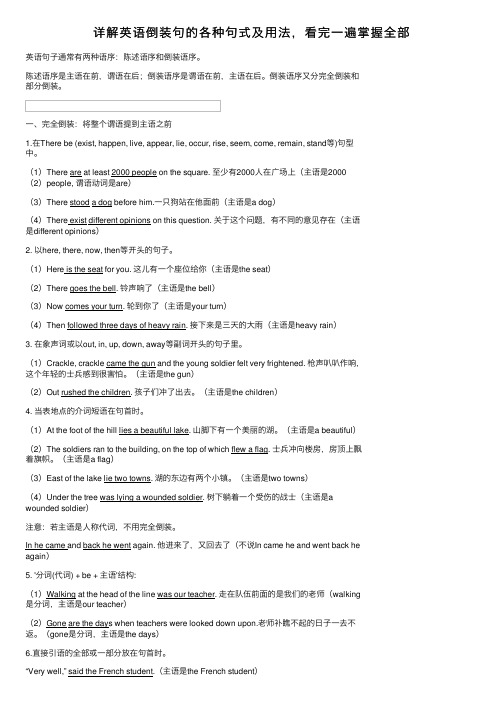
详解英语倒装句的各种句式及⽤法,看完⼀遍掌握全部英语句⼦通常有两种语序:陈述语序和倒装语序。
陈述语序是主语在前,谓语在后;倒装语序是谓语在前,主语在后。
倒装语序⼜分完全倒装和部分倒装。
⼀、完全倒装:将整个谓语提到主语之前1.在There be (exist, happen, live, appear, lie, occur, rise, seem, come, remain, stand等)句型中。
(1)There are at least 2000 people on the square. ⾄少有2000⼈在⼴场上(主语是2000(2)people, 谓语动词是are)(3)There stood a dog before him.⼀只狗站在他⾯前(主语是a dog)(4)There exist different opinions on this question. 关于这个问题,有不同的意见存在(主语是different opinions)2. 以here, there, now, then等开头的句⼦。
(1)Here is the seat for you. 这⼉有⼀个座位给你(主语是the seat)(2)There goes the bell. 铃声响了(主语是the bell)(3)Now comes your turn. 轮到你了(主语是your turn)(4)Then followed three days of heavy rain. 接下来是三天的⼤⾬(主语是heavy rain)3. 在象声词或以out, in, up, down, away等副词开头的句⼦⾥。
(1)Crackle, crackle came the gun and the young soldier felt very frightened. 枪声叭叭作响,这个年轻的⼠兵感到很害怕。
(主语是the gun)(2)Out rushed the children. 孩⼦们冲了出去。
英语倒装句学习:倒装句解析

英语倒装句学习:倒装句解析什么时候倒装以及怎样倒装1、 here,there等地点和方向副词位于句首,用全部倒装,目的是强调状语Here comes a bus.来了一辆公共汽车。
正常语序:A bus comes here.There goes the last train.最后一班火车开走了。
正常语序:The last train goes there.解释一下:倒装主要为了强调,强调的内容放在句首,比如强调here 放到句首,这时就必须用倒装句,把谓语comes 提到主语前面。
像 Here a bus comes. 这种表达是错误的。
这种情况下用全部倒装,就是把所有谓语部分都移动到主语前面,谓语是comes,移动到主语前面,注意这句话的句子成分,bus 是名词,作主语,comes是(不及物)动词,作谓语,这句话没有宾语,here是副词,作状语。
类似还有back, down,off, up, in, out 等表示运动方向的副词:Up went the rocket into the air.火箭升上天空。
正常语序:The rocket went up into the air.Out rushed a young lady.一个年轻女士冲了出来。
正常语序:A young lady rushed out.当我们表达给别人东西或确定人的位置的时候也用倒装(全部倒装),这种倒装常常在 be 动词之后。
Here’s a cup of tea for you.给你一杯茶。
There’s Kate.凯特在那儿。
还有一条例外规则:当主语是代词的时候不用倒装。
He comes here. 他来了。
(正常语序)强调状语here的时候,here提到句首,而主语和谓语位置不发生变化:Here he comes.而不是:Here comes he.Here you are.给你。
而不是:Here are you.2、介词短语充当的地点状语后的倒装:此时依然用全部倒装,谓语动词一般是表示位置的动词如:lie, live, sit, stand 等或转移动词如 come, go, rise 等。
什么是倒装句

什么是倒装句?倒装句(Inversion)是英语中的一种语法结构,它改变了正常的主谓语序,将助动词、情态动词或连词放在主语之前,从而使句子的语序倒置。
倒装句在英语中的使用非常常见,可以用于不同的语境和句型中。
下面是倒装句的一些常见用法:1. 完全倒装:在完全倒装句中,助动词、情态动词或连词被放在主语之前,形成倒装结构。
这种倒装常用于以下情况:-在以地点或时间副词开头的句子中,表示强调或突出地点或时间。
-在以表示条件的连词“if”和“unless”引导的句子中。
-在以“so”和“neither”引导的句子中,表示同样的情况或意见。
-在以“not only...but also”引导的句子中,表示并列关系。
- In the corner of the room stood a beautiful piano.(地点副词开头)- If I were you, I would take that job.(条件句倒装)- So does he.(表示同样的情况或意见)- Not only did she study for the exam, but she also helped her classmates.(并列关系)2. 部分倒装:在部分倒装句中,只有助动词或情态动词被放在主语之前,形成倒装结构。
这种倒装常用于以下情况:-在以否定副词或短语开头的句子中,表示强调。
-在以“so”或“neither”引导的句子中,表示同样的情况或意见。
- Never have I seen such a beautiful sunset.(否定副词开头)- So have I.(表示同样的情况或意见)3. 问句倒装:在一般疑问句、特殊疑问句和反意疑问句中,谓语动词和助动词被调换位置,形成倒装结构。
- Did you go to the party last night?(一般疑问句)- What time does the train leave?(特殊疑问句)- You like ice cream, don't you?(反意疑问句)倒装句在英语中的使用非常灵活,可以用于不同的语境和句型中。
- 1、下载文档前请自行甄别文档内容的完整性,平台不提供额外的编辑、内容补充、找答案等附加服务。
- 2、"仅部分预览"的文档,不可在线预览部分如存在完整性等问题,可反馈申请退款(可完整预览的文档不适用该条件!)。
- 3、如文档侵犯您的权益,请联系客服反馈,我们会尽快为您处理(人工客服工作时间:9:00-18:30)。
倒装句详解概念:用以表示一定句子结构的需要和强调某一句子成分的需要, 分为完全倒装和部分倒装.一.完全倒装:句子中的谓语动词全部置于主语之前.此结构通常只用与一般现在时和一般过去时.1.以here, there, now, then等副词或out, in, up, down, away等表示运动方向的副词或地点状语置于句首以示强调, 句子要全部倒装, 谓语动词常用come,go, be, lie,run,rush等.2. 表示地点的介词短语位于句首时A beautiful lake lies at the foot of the hillAt the foot of the hill lies a beautiful lake.注意:在上述句子中, 如果主语为人称代词, 则主、谓不需要倒装.In he came and back he went again.Away he went .二.部分倒装:be/助动词/情态动词提前到主语的前面.Is am are was were(be动词)do does did(助动词)can could would may will might(情态动词)等1.only所修饰的副词、介词短语或状语从句放在句首时, 要进行部分倒装.Only then did I realize the importance of learning English.Only after he came back was I able to see him.注:only修饰主语, 仍用自然语序, 如:Only socialism can save China.I seldom go to the cinema.倒装:Seldom do I go to the cinema.我很少去看电影.I have never seen such a performance.倒装:Never have I seen such a performance.我从来没有看过这样的表演.2.否定副词及介词短语的否定词位于句首时.高考常考的这类词或词语有:never , not, seldom, hardly, little, nowhere, by no means, in no time等.3.not until 引导的从句位于句首引起的主句部分倒装He didn’t finish his homework until his mother came back.倒装:Not until his mother came back did he finish his homework.直到他的妈妈回来, 他才完成作业.The mother didn’t leave the room until the child fell asleep.倒装:Not until the child fell asleep did the mother leave the room.等到孩子睡着了, 妈妈才离开房间.注意:当Not until引出主从复合句, 主句倒装, 从句不倒装.4、as/ though (虽然, 尽管)引导的让步状语从句名词\形容词\副词\分词+as\though+主语+其他Although I am ugly, I am gentle.倒装:Ugly as I am, I am gentle.Though he is a child, he has to make a living.倒装:Child as he is, he has to make a living.注意:从句的表语是名词, 其名词前不加任何冠词5.用于so nor neither 开头的句子A、So +be/助动词/情态动词+主语某人也是如此Nor/neither +be/助动词/情态动词+主语某人也不是如此1). 他喜欢读书, 我也是.He likes reading very much. So do I .2). 我从来没有去过广州大学, 他也是.I have never been to Guangzhou University, neither/ nor has he.Betty is a nice girl. So she isB、So +主语+be/助动词/情态动词某人确实如此6.在hardly/scarcely/…when;no sooner…than; not only … but also;so...that; such…that 的倒装句中, 前倒后不倒. hardly/scarcely/ no sooner后句子的谓语用had done, when/than后句子的谓语用一般过去时(1) Hardly / Scarcely had he fallen asleep when a loud knock at the door awaked him.(2) No sooner had I reached the station than train moved.(3) Not only is he interested in football but also he plays it well.(4) So hard does he work that he has made great progress in English.7. If 虚拟条件从句中.从句有(were/should/had)1)If I were you, I would work hard. 倒装:Were I you, I would work hard.2) If it should rain tomorrow, we would put off our meeting.倒装: Should it rain tomorrow, we would put off our meeting.3)If he had followed my advice, he would have succeeded.倒装:Had he followed my advice, he would have succeeded.8.May置句首, 表示祝愿.May you succeed.祝你成功!补充知识1.全部倒装全部倒装是只将句子中的谓语动词全部置于主语之前.此结构通常只用于一般现在时和一般过去时.常见的结构有:1)here, there, now, then, thus等副词置于句首, 谓语动词常用be, come, go, lie, run等表示来去或状态的动词.Then came the chairman. 那时总裁来了.Here is your letter. 你的信.2)表示运动方向的副词或地点状语置于句首, 谓语表示运动的动词.Out rushed a missile from under the bomber. 轰炸机肚底下窜出一枚导弹.Ahead sat an old woman. 前面坐着一个老妪.注意:上述全部倒装的句型结构的主语必须是名词, 如果主语是人称代词则不能完全倒装.Here he comes. 他来了.Away they went. 他们走开了.2.部分倒装部分倒装是指将谓语的一部分如助动词或情态倒装至主语之前.如果句子的谓语没有助动词或情态动词, 则需添加助动词do, does或did, 并将其置于主语之前.1.句首为否定或半否定的词语, 如no, not, never, seldom, little, hardly, at no time决不, in no way, not until… 等. Never have I seen such a performance. 从未见过如此糟糕的表演.Nowhere will you find the answer to this question. 无论如何你不会找到这个问题的答案的.Not until the child fell asleep did the mother leave the room. 母亲一直到孩子入睡后离开房间.2.当Not until引出主从复合句, 主句倒装, 从句不倒装.注意:如否定词不在句首不倒装.I have never seen such a performance. ---never have I seen such a performance.The mother didn\'t leave the room until the child fell asleep.---not until the child fell asleep the mother did leave the room.改写为正常语序为, Man did not know what heat is until the early years of the 19th. 现在将not提前, 后面就不能再用否定了,否则意思就变了.3.以否定词开头作部分倒装如Not only…but also, Hardly/Scarcely…when, No sooner… than等, 要倒装.Not only did he refuse the gift, he also severely criticized the sender. 他没有收下礼物, 还狠狠批评了送礼的人. Hardly had she gone out when a student came to visit her. 她刚出门, 就有个学生来访.No sooner had she gone out than a student came to visit her. 她刚出门, 就有个学生来访.4. so, neither, nor作部分倒装用这些词表示\"也\"、\"也不\" 的句子要部分倒装.Tom can speak French. So can Jack. 汤姆会讲法语, 杰克也会.If you won\'t go, neither will I.你不去, 我也不去.注意:当so引出的句子用以对上文内容加以证实或肯定时, 不可用倒装结构.意为\"的确如此\".Tom asked me to go to play football and so I did. 汤姆邀我去踢球, 我去了.---It\'s raining hard.---So it is. 雨下得真大.是呀.5. only在句首倒装的情况.Only in this way, can you learn English well. 只有这样, 你才能学好英语.Only after being asked three times did he come to the meeting. 叫了三次, 他才来参加会议.如果句子为主从复合句, 则主句倒装, 从句不倒装.Only when he is seriously ill does he ever stay in bed. 病得狠重时, 他才卧床休息.6. as, though 引导的倒装句as / though引导的让步从句必须将表语或状语提前(形容词, 副词, 分词, 实义动词提前).但需注意:1)句首名词不能带任何冠词.2)句首是实义动词, 其他助动词放在主语后.如果实义动词有宾语和状语, 随实义动词一起放在主语之前.Try hard as he will, he never seems able to do the work satisfactorily. 他工作很努力, 但总不能让人满意.注意:让步状语从句中, 有though, although时, 后面的主句不能有but, 但是though 和yet可连用.7. 其他部分倒装1)so… that 句型中的so 位于句首时, 需倒装.So frightened was he that he did not dare to move an inch. 他害怕得很, 动也不敢动.2)在某些表示祝愿的句型中.例如:May you all be happy. 愿你们都快乐.3)在虚拟语气条件句中从句谓语动词有were, had, should等词, 可将if 省略, 把were, had, should 移到主语之前, 采取部分倒装.例如:Were I you, I would try it again. 我是你的话, 就再试一次.深化拓展一、全倒装:五全=有时表地方经常与be/come/exist/fall/follow/go/remain/seem/stand(表示移动或动态的不及物动词连用)或用表示类似存在观念的其他不及物动词如:live, stand, come, lie, flow, enter, rise 和appear等1、有:在there be结构里There is a box on the table.桌子上面有一个盒子.2、时:表示时间副词, 如:now, then,Now comes your turn.现在轮到你了.3、表:表语放句子前,表语+系动词+主语的结构Present at the party were Mr. Green and many other guests.格林先生和其他的客人在这个聚会上.Seated on the ground are a group of young men.一群年轻人坐在了地上.4、地:地点状语放在句首In south of the river lies a small factory. 小工厂位于河的南方.From the valley came a cry.山谷传来一阵哭声.5、方:表方位的副词here, there 或out, in, up, down, away, off等标志词放在句首There lies a large wheat field in front of the house.房子前面有一大片麦田.Off all the lights went when I came in.当我进来时, 所有的灯都灭了.二、半倒装:八部=不只让步也常需(虚)如此祝福1、不表示否定①no, not, never, hardly, no,not,never,hardly,barely,seldom,rarely,scarcely,no longer,nowhere Never have I been to Beijing.我从没有没有去过北京.②绝不:at n time, in no way, by no means, on no account, in no case, in/under no circumstance At no time can we give up.我们决不能放弃.③Not until ...:直到Not until my mother came home did I go to bed.知道我妈妈回家我才睡觉.④Hardly/ Scarcely...(过完)...when...(一过)...:一...就...No sooner...(过完)...than...(一过)...:一...就...He had hardly got home when it happened to rain.=Had he hardly got home when it happened to rain.他一到家碰巧就下雨了.⑤Not only......but also......:(前倒后不倒)Not only did he refuse the gift, he also severely criticized the sender.他没有收下礼物, 还狠狠批评了送礼的人2、只:only所修饰的副词、介词短语或状语从句放在句子开头时.Only then did I realize that I was wrong.只有到那时我才意识到我错了.Only in this way can you learn from your mistake.只有用这样的方法你可以从错误中学习.Only when the war was over in 1918 was he able to get happily back to work.只有当战争于1918年结束时候, 他才能够快乐地回到工作当中.※当only 之后所接的不是状语时不可以用倒装Only Comrade Zhang knows about the matter..只有张同志知道这件事.3、让步:as/though/although引导让步状语从句时要倒装(形/副/名/动+as +主语+ 谓语)Proud as they are, they are afraid to see me.尽管他们自豪, 但是他们还怕见到我.Child as he is, he seems to know everything.(child前不加冠词)尽管他是个孩子, 但他好像知道一切.Hard as he worded, he made little progress.尽管他努力工作, 但是几乎没什么进步.※以上句中as可以替换though/although, 但是as更加常用.4、也:so/nor/neither开头,表示谓语所述的情况也适用于另一个人或一事物的肯定或否定句so用于肯定句, 表示也一样也这样;nor/neither用于否定句, 表示同样也不, 也不这样.I am watching TV. So is she.我正在看电视, 她也在看.My parents didn't watch TV last night. Neither (Nor)did I.我父母昨晚没有看电视, 我也没有看.※表示两人的同样一个情况时, 只能表示一件事, 即上、下句所使用的动词、时态要一致.5、常:表示频度副词如:often、many a time, now and again等经常用于正式的文体中Often did he advise them not to smoke.他经常建议他们不要抽烟.6、需=虚拟:省略if的虚拟条件句, 把助动词were、had、should提到主语前面时Had it not been for your help, we shouldn't have achieved so much.要不是你的帮助, 我们不可能收获这么多.7、如此:so/such …that….从句中, 当so+形容词/副词或such+名词位于句首时.So exhausted was she that she wanted to have a rest.他是如此地疲惫以至于想要休息一下.8、祝福:当may放在句首, 表达祝愿时.May you succeed! 祝你成功!。
